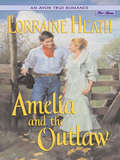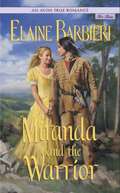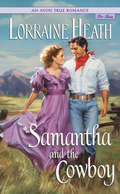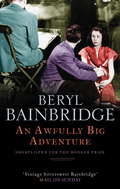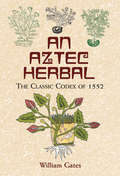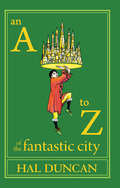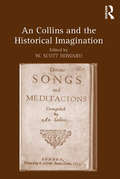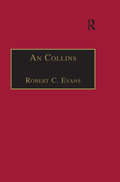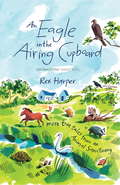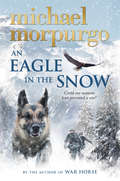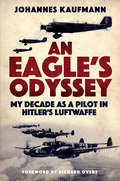- Table View
- List View
An Avocado a Day: More than 70 Recipes for Enjoying Nature's Most Delicious Superfood
by Lara FerroniGo beyond guacamole! Research shows that adding an avocado a day to your diet helps improve your overall health, and this cookbook will show you how to enjoy avocados in 70 delicious and different ways. Even most avocado lovers don't know what to do with them beyond adding a slice or two to a sandwich or mashing one into guacamole. Here are 70 simple and delicious tasty recipes for everything from breakfast to dessert, including Avocado Green Curry Noodles, Tequila, Citrus and Ginger Stuffed Avocados, Avocado Waffles, and Avocado Key Lime Pie. Lara Ferroni educates readers on the various kinds of avocados and how to pick them, store them, and even grow them! Home cooks will learn how to make use avocado butter, oil, and honey, and how to incorporate avocados into any every meal of the day.From the Hardcover edition.
An Avon True Romance: Amelia and the Outlaw
by Lorraine HeathAmeliaWith a strict, eagle-eyed judge for a father and two older brothers to back him up, Amelia Harper is doted upon and protected within an inch of her life. She's not even allowed to have a sweetheart until she's seventeen, for example. Amelia longs for the day she can do as she pleases, but that day doesn't seem to be in any hurry to arrive.The OutlawFor a young fellow, Jesse Lawton has a surprisingly shady background. The only wonder is that it took him until the age of fourteen to end up in jail, so wild was the path he'd been on. But five years have passed, and his luck finally seems to have turned: he's been freed. If only he can stay on the straight and narrow . . .When Jesse arrives at the Harper ranch to work off the remainder of his sentence, it's no surprise that the judge's pretty daughter catches his eye. What he doesn't know is that this young lady is itching for excitement, and with one look into his haunted eyes, Amelia knows she's found it in Jesse. Without meaning to, Amelia forces the erstwhile outlaw into a choice between his freedom and his heart.
An Avon True Romance: Miranda and the Warrior
by Elaine BarbieriJust as the Avon name means adult romance, so the name Avon True Romance will mean captivating love stories for the younger set. Written with teen readers in mind, our books will tap into the young adult market while maintaining the high level of passionate writing that the adult Avon romances possess. It's 1852. Defiant 17-year-old Miranda leaves her South Dakota fort in spite of her father's warnings of the presence of Cheyenne war tribes. Before she knows what has happened, she's nabbed by a celebrated warrior who is just as stubborn as Miranda.
An Avon True Romance: Samantha and the Cowboy
by Lorraine HeathSamanthaWhen she manages to get herself hired for the cattle drive, all of Samantha's prayers seem to be answered. The hundred dollars she'll earn will pull her family's Texas farm out of ruin and pay off their debts. But keeping the cowhands fooled that she's a boy becomes harder than she'd expected where one cowboy in particular is concerned.The CowboyMatthew Hart wants two things: to forget the tragedies he witnessed on the front lines of the War Between the States, and to reclaim his cowboy life. The last thing he wants is the responsibility of a tagalong youngster on the cattle drive. His closed mind and hardened heart are territory best left unexplored, until a fateful moment turns his world upside down.Matt discovers what and who "Sam" really is, and he is furious. But soon a stronger emotion takes hold, and bound by Samantha's secret, Matt is torn between revealing her identity and his own sudden and frightening love for her.
An Avon True Romance: Samantha and the Cowboy
by Lorraine HeathSamanthaWhen she manages to get herself hired for the cattle drive, all of Samantha's prayers seem to be answered. The hundred dollars she'll earn will pull her family's Texas farm out of ruin and pay off their debts. But keeping the cowhands fooled that she's a boy becomes harder than she'd expected where one cowboy in particular is concerned.The CowboyMatthew Hart wants two things: to forget the tragedies he witnessed on the front lines of the War Between the States, and to reclaim his cowboy life. The last thing he wants is the responsibility of a tagalong youngster on the cattle drive. His closed mind and hardened heart are territory best left unexplored, until a fateful moment turns his world upside down.Matt discovers what and who "Sam" really is, and he is furious. But soon a stronger emotion takes hold, and bound by Samantha's secret, Matt is torn between revealing her identity and his own sudden and frightening love for her.
An Awakened Life: Using Everyday Experiences for Inner Fulfilment
by Christopher TitmussIn an awakened life, our hearts are open, steady and purposeful. Most people today have a greater income, as well as more goods and labour - saving devices, than any other generation in history. Yet stress, discontent, personal and social problems abound. Drawing on the deepest discoveries of the Buddhist tradition, well-known retreat master, Christopher Titmuss, suggests we spend far too much time in superficial preoccupaions and not enough in looking deeply into things. He urges us to fearlessly transform the forces of desire and dissatisfaction that haunt our daily lives - and to awaken to the Immeasurable. Inspired by the 20th Century classic, Zend Mind, Beginner's mind, he gives practical advice on such subjects as: understanding our feelings , taking risks, becomming more detached and rediscovering our true selves. And he shows us how to have free, fulfilled and uninhibited lives amidst the frenzy of everyday activity.
An Awesome Book!
by Dallas ClaytonBased on the simple concept of dreaming big, An Awesome Book! is the inspiring debut work of Los Angeles writer/artist Dallas Clayton. Written in the vein of classic imaginative tales, it is a sure hit for all generations, young and old.
An Awfully Beastly Business: The Big Beast Sale
by David Sinden Guy Macdonald The Beastly BoysUlf the werewolf is on his most dangerous mission yet - to Capitol City, where wicked Baron Marackai is plotting the return of the beast trade and the end of the RSPCB. With the public calling for beasts to be banished or, worse, destroyed, the future of ALL beasts depends on Ulf. . .
An Awfully Big Adventure: A Novel (Bainbridge, Beryl Ser.)
by Beryl BainbridgeShortlisted for the Man Booker Prize: In postwar Liverpool, a teenager joins a theater troupe to escape her working-class life--and is drawn into a darker world. From one of Britain's best-loved novelists, this is the story of Stella Bradshaw, an orphaned sixteen-year-old with dreams of getting out of her boardinghouse in the slums. Unwilling to resign herself to a job at Woolworth's, she finds a place at the Liverpool Repertory Company instead. She quickly falls head over heels for the rundown theater's dissolute director, Meredith Potter, but he has no interest in her. And Stella is too naïve to understand why. As she tries to gain experience with other colleagues in the hope of one day seducing Meredith, the director is faced with a crisis when a cast member is injured just as the company's production of Peter Pan is about to open. The replacement is an older man, a war hero and a prominent actor--and he's instantly drawn to Stella. But while the romance that follows may be innocent, its implications are far from wholesome. Named by the Times (London) as one of the "fifty greatest British writers since 1945," author Beryl Bainbridge portrays working-class England in the aftermath of World War II with her signature dark humor and dry wit. Adapted into a 1995 film starring Hugh Grant and Alan Rickman, An Awfully Big Adventure is an atmospheric historical novel about the loss of innocence with a definitively modern--and chilling--twist.This ebook features an illustrated biography of Beryl Bainbridge including rare images from the author's estate.
An Awfully Big Adventure: An Awfully Big Adventure, The Birthday Boys, And Master Georgie
by Beryl BainbridgeIt is 1950 and the Liverpool reporatory theatre company is rehearsing its Christmas production of Peter Pan, a story of childhood innocence and loss. Stella has been taken on as assistant stage manager and quickly becomes obsessed with Meredith, the dissolute director. But it is only when the celebrated O’Hara arrives to take the lead, that a different drama unfolds. In it, he and Stella are bound together in a past that neither dares to interpret.
An Awfully Big Adventure: Shortlisted for the Booker Prize, 1990
by Beryl Bainbridge'This is one of Bainbridge's best books. The close observation and hilarity are underlain by a sense of tragedy as deep as any in fiction' The TimesSHORTLISTED FOR THE BOOKER PRIZE IN 1990It is 1950 and the Liverpool repertory theatre company is rehearsing its Christmas production of Peter Pan, a story of childhood innocence and loss. Stella has been taken on as assistant stage manager and quickly becomes obsessed with Meredith, the dissolute director. But it is only when the celebrated O'Hara arrives to take the lead, that a different drama unfolds. In it, he and Stella are bound together in a past that neither dares to interpret.
An Awkward Way to Die: A Barker & Llewelyn Short Story
by Will ThomasAn original never-before-seen Barker and Llewelyn short story: includes 7 FREE CHAPTERS of OLD SCORES, the next installment in the adventures of Cyrus Barker and Thomas Llewelyn.Cyrus Barker, the most prominent and accomplished private enquiry agent in 19th century London, faces what might be the most dastardly crime of his career: his personal tobacconist has been murdered, his body found in his own humidor!Now Cyrus Barker, with the help of his assistant, Thomas Llewelyn, must crisscross London in order to track the killer. As they follow the clues, Barker discovers that the victim, Vasilios Dimitriadis, was not a man worthy of Barker's trust. Can the Guv find whoever killed the skilled tobacco blender? While he is at it, can he find the secret formula Dimitriadis used to make his beloved tobacco blend?
An Axiomatic Approach to Geometry: Geometric Trilogy I
by Francis BorceuxFocusing methodologically on those historical aspects that are relevant to supporting intuition in axiomatic approaches to geometry, the book develops systematic and modern approaches to the three core aspects of axiomatic geometry: Euclidean, non-Euclidean and projective. Historically, axiomatic geometry marks the origin of formalized mathematical activity. It is in this discipline that most historically famous problems can be found, the solutions of which have led to various presently very active domains of research, especially in algebra. The recognition of the coherence of two-by-two contradictory axiomatic systems for geometry (like one single parallel, no parallel at all, several parallels) has led to the emergence of mathematical theories based on an arbitrary system of axioms, an essential feature of contemporary mathematics. This is a fascinating book for all those who teach or study axiomatic geometry, and who are interested in the history of geometry or who want to see a complete proof of one of the famous problems encountered, but not solved, during their studies: circle squaring, duplication of the cube, trisection of the angle, construction of regular polygons, construction of models of non-Euclidean geometries, etc. It also provides hundreds of figures that support intuition. Through 35 centuries of the history of geometry, discover the birth and follow the evolution of those innovative ideas that allowed humankind to develop so many aspects of contemporary mathematics. Understand the various levels of rigor which successively established themselves through the centuries. Be amazed, as mathematicians of the 19th century were, when observing that both an axiom and its contradiction can be chosen as a valid basis for developing a mathematical theory. Pass through the door of this incredible world of axiomatic mathematical theories!
An Aztec Herbal: The Classic Codex of 1552 (Native American)
by William GatesOriginally written in the Aztec language, this 16th-century codex was the first herbal and medical text compiled in the New World. It contains ancient remedies for myriad ailments -- boils, hair loss, cataracts, insomnia hiccoughs, and gout, to name a few. Analytical Index to Plants. New Introduction. Over 180 black-and-white and 38 color illustrations.
An AZ of the Fantastic City: A Guidebook for Readers and Explorers
by Hal Duncan Eric SchallerSexy, secretive, yet clear-eyed, Duncan brings pop, high, and low cultures together in one handy sometimes amusing sometimes harsh A-to-Z which every bibliophile and armchair adventurer will find to be a necessary guidebook through the temerarious pages of international literature.
An A–Z Guide to Food Additives: Never Eat What You Can't Pronounce
by Deanna M. MinichA reference for decoding what those mysterious ingredients are—and how they may affect you: “The definitive guide for the health-conscious shopper.” —Robert H. Lerman, MD, PhDHere’s a tongue twister: Say cochineal extract, diacetyl, tertiary butylhydroquinone, BHA, HFCS, and MSG. It's not just knowing how to pronounce what’s in your food that’s important, it's knowing what it does and how it can affect you. The average American consumes about 150 pounds of food additives per year. With so many processed foods on the supermarket shelves, it can be hard to navigate the waters to an additive-free diet.A-Z Guide to Food Additives helps you change the way you eat and shop—providing heart-healthy tips while helping you avoid undesirable food additives. Also, you’ll get the rundown on which additives do no harm and may even be nutritious. This “additive translator” lets you head down to your grocery store with a grocery list in one hand and your newfound knowledge in the other.A-Z Guide to Food Additives delivers:Essential nutrition adviceHints on what to look for when reading those unreadable ingredient labelsTips on buying fresh produce in order to avoid pesticidesInformation on ingredients that can contribute to headaches, bloating, breathing difficulties, and other problemsSafety ratings for 300 ingredientsReference charts for additives that may cause cancer or allergic reactions, or should be limited for sodium-sensitive people
An A–Z Guide to Healing Foods: A Shopper's Reference (Conari Wellness)
by Elise Marie CollinsFind foods that fill you with a sense of well-being—and benefit your body—with this alphabetical, cross-referenced guide: “Fantastic.” —Christiane Northrup, MD, #1 New York Times-bestselling author of Women’s Bodies, Women’s WisdomFilled with scientific information, natural remedies, and modern wisdom, this concise reference is for anyone confused by all the nutritional claims out there. How do you separate real benefits from marketing hype? What is a “superfood” anyway? Alternative health expert Elise Collins has compiled a compact yet comprehensive list of hundreds of healing foods, their vitamin and mineral content, and what they do to promote health, prevent disease, and decrease symptoms of illness.Arranged alphabetically and complete with a cross-reference for what's best to eat for specific ailments, this guidebook is designed to be as convenient as a shopping list. Included are preparation tips and recipes to make this the ultimate tool for joyful eating and radiant health.“Encyclopedic information on the nutritional, medical, and holistic benefits of foods.” —Dana Jacobi, author of 12 Best Foods Cookbook
An Collins and the Historical Imagination
by W. Scott HowardThe first edited collection of scholarly essays to focus exclusively on An Collins, this volume examines the significance of an important religious and political poet from seventeenth-century England. The book celebrates Collins’s writing within her own time and ours through a comprehensive assessment of her poetics, literary, religious and political contexts, critical reception, and scholarly tradition. An Collins and the Historical Imagination engages with the complete arc of research and interpretation concerning Collins’s poetry from 1653 to the present. The volume defines the center and circumference of Collins scholarship for twenty-first century readers. The book’s thematically linked chapters and appendices provide a multifaceted investigation of An Collins’s writing, religious and political milieu, and literary legacy within her time and ours.
An Collins: Printed Writings 1641–1700: Series II, Part Two, Volume 1 (The Early Modern Englishwoman: A Facsimile Library of Essential Works & Printed Writings, 1641-1700: Series II, Part Two #Pt. 2)
by Robert C. EvansAn Collins' Divine Songs and Meditacions were first printed in a small octavo volume in London in 1653. The only extant copy is presently held at The Huntington Library and it is, therefore, this copy that is reproduced in this facsimile edition. It is an important text because it is one of the earliest volumes of collected poems by an English woman in the seventeenth century. The poems are especially intriguing because of the glimpses they provide into the life and mind of a woman writer during this period and because of the social, political, historical and religious contexts in which they are embedded. The precise identity of An Collins' remains a mystery, and scholars have had to rely on the Divine Songs and Meditacions for most of their understanding of its author, often drawing very different conclusions about her religious, social and political beliefs. To date critics have focused on the biographical and historical interest of the poems, but as Robert Evans highlights in his Introductory Note to the volume, these works also exhibit a rhetorical power and skill that merits further attention.
An ER Nurse to Redeem Him (Wyckford General Hospital #2)
by Traci DouglassIn the latest installment of Traci Douglass&’s Wyckford General Hospital quartet, discover what happens when attending a charity event together ends in the nurse and the EMT sharing an earth-shattering kiss! A REASON TO STAY? Flying EMT Tate is the new guy in town, but he won&’t be staying long. Grief and guilt keep this ex-military medic on the move. Inadvertently becoming ER nurse Madi&’s date to a charity auction should change nothing… But that&’s before Tate and the usually cautious-in-love Madi share a toe-curling kiss! Is their unexpected connection the key to redeeming this haunted hero?From Harlequin Medical: Life and love in the world of modern medicine.Wyckford General Hospital Book 1: Single Dad's Unexpected ReunionBook 2: An ER Nurse to Redeem HimBook 3: Her Forbidden Firefighter
An Eagle Named Freedom: My True Story of a Remarkable Friendship
by Jeff Guidry“A hauntingly beautiful story of rescue and rehabilitation….[A] gorgeous tale of redemption.”—Susan Richards, New York Times bestselling author of Chosen by a Horse“I could not put this book down.”—Stacey O'Brien, New York Times bestselling author of Wesley the OwlFrom the moment Jeff Guidry saw the emaciated baby eagle with broken wings, his life was changed. For weeks he and the staff at Sarvey Wildlife Care Center tended to the grievously injured bird. Miraculously, she recovered, and Jeff, a center volunteer, became her devoted caretaker.Though Freedom would never fly, she had Jeff as her wings. And after Jeff was diagnosed with stage 3 non-Hodgkin's lymphoma in 2000, Freedom returned his gift. Between sessions of debilitating chemotherapy, Jeff went back to Sarvey and began taking Freedom for walks that soothed his spirit and gave him the strength to fight. A tender tale of hope, love, trust, and life, this moving true story is an affirmation of the spiritual connection that humans and animals share.
An Eagle in the Airing Cupboard
by Rex HarperAN EAGLE IN THE AIRING CUPBOARD picks up where Rex Harpers first book, AN OTTER ON THE AGA, left off. It follows the fortunes of the Cornish RSPCA centre through one of its most testing twelve months. Once more it is a mixture of funny, touching and sometimes moving animal stories. And once more it features a cast of unforgettable characters, like Alfie and Blue, two hideously mistreated greyhounds that are rehabilitated at the farm, as well as the return of old favourites from Rex's first book, including his loyal dog Moss. Throughout, Rex evokes the sights, smells, sounds and spirit of the Cornish countryside in all its timeless beauty. He also encounters sickening cases of animal cruelty committed by humans unfit to care for any living thing. Funny, warm and evocative, it is a book that is, once more, set to melt and occasionally break the hearts of animal lovers everywhere.
An Eagle in the Airing Cupboard
by Rex HarperAN EAGLE IN THE AIRING CUPBOARD picks up where Rex Harpers first book, AN OTTER ON THE AGA, left off. It follows the fortunes of the Cornish RSPCA centre through one of its most testing twelve months. Once more it is a mixture of funny, touching and sometimes moving animal stories. And once more it features a cast of unforgettable characters, like Alfie and Blue, two hideously mistreated greyhounds that are rehabilitated at the farm, as well as the return of old favourites from Rex's first book, including his loyal dog Moss. Throughout, Rex evokes the sights, smells, sounds and spirit of the Cornish countryside in all its timeless beauty. He also encounters sickening cases of animal cruelty committed by humans unfit to care for any living thing. Funny, warm and evocative, it is a book that is, once more, set to melt and occasionally break the hearts of animal lovers everywhere.
An Eagle in the Snow
by Michael MorpurgoEngland, 1940. Barney’s home has been destroyed by bombing, and he and his mother are traveling to the countryside when German planes attack. Their train is forced to take shelter in a tunnel and there, in the darkness, a stranger— a fellow passenger—begins to tell them a story about two young soldiers who came face to face in the previous war. One British, one German. Both lived, but the British soldier was haunted by the encounter once he realized who the German was: the young Adolf Hitler.The British soldier made a moral decision. Was it the right one? Readers can ponder that difficult question for themselves with Michael Morpurgo's latest middle-grade novel An Eagle in the Snow.
An Eagle's Odyssey: My Decade as a Pilot in Hitler's Luftwaffe
by Johannes KaufmannThe first English translation of one German military pilot&’s experience before, during, and after World War II flying for the Third Reich. Johannes Kaufmann&’s career was an exciting one. He may have been an ordinary Luftwaffe pilot but he served during an extraordinary time with distinction. Serving for a decade through both peacetime and wartime, his memoir sheds light on the immense pressures of the job. In this never-before-seen translation of a rare account of life in the Luftwaffe, Kaufmann takes the reader through his time in service, from his involvement in the annexation of the Rhineland, the attack on Poland, fighting against American heavy bombers in the Defense of the Reich campaign. He also covers his role in the battles of Arnhem and the Ardennes, and the D-Day landings, detailing the intricacies of military tactics, flying fighter planes and the challenges of war. His graphic descriptions of being hopelessly lost in thick cloud above the Alps, and of following a line of telegraph poles half-buried in deep snow while searching for a place to land on the Stalingrad front are proof that the enemy was not the only danger he had to face during his long flying career. Kaufmann saw out the war from the early beginnings of German expansion right through to surrender to the British in 1945. An Eagle&’s Odyssey is a compelling and enlightening read, Kaufmann&’s account offers a rarely heard perspective on one of the core experiences of the Second World War.

